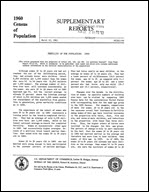1960 Census: Population, Supplementary Reports: Fertility of the Population
1960 Census: Population, Supplementary Reports: Fertility of the Population
The tables presented here are preprints of tables 190, 192, and 284 (or portions thereof) from Final Report PC(1)-1D, which contains additional summary information on the detailed characteristics of the population.
Although women 30 to 39 years old had not reached the end of the childbearing period, they had already borne more children (about 2,500 children per 1,000 women) than the women who were 45 to 49 years old (2,245 children per 1,000 women). The average number of children ever born will increase considerably as the women who were 30 to 39 years old in 1960 approach age 45, but the current average is already 17 percent above the lifetime average of about 2,140 children per 1,000 women needed for replacement of the population from generation to generation, given mortality conditions as in 1959.
The experience of the cohort of women who were 50 to 54 years old in 1960 represents a turning point in the trend in completed fertility. They had an average of only 2,176 children ever born per 1,000 women, which is the lowest national average on record for completed fertility. Women at successively older ages in 1960 had successively higher averages because of a previous trend toward smaller families that ended with the women 50 to 54 years old in 1960.
Women 30 to 34 years old in 1960 who had married were young enough to have participated in the postwar pattern of earlier marriage. They had borne nearly as many children on the average as women 35 to 39 years old. They had a lower percent of childlessness (10.4 percent for women age 30 to 34 as compared with 11.1 percent for women age 35 to 39) and a lower percent who had borne only one child (14.7 percent and 15.1 percent, respectively).
The PDF to the right contains the 6-page report.
A Note on Language
Census statistics date back to 1790 and reflect the growth and change of the United States. Past census reports contain some terms that today’s readers may consider obsolete and inappropriate. As part of our goal to be open and transparent with the public, we are improving access to all Census Bureau original publications and statistics, which serve as a guide to the nation's history.




